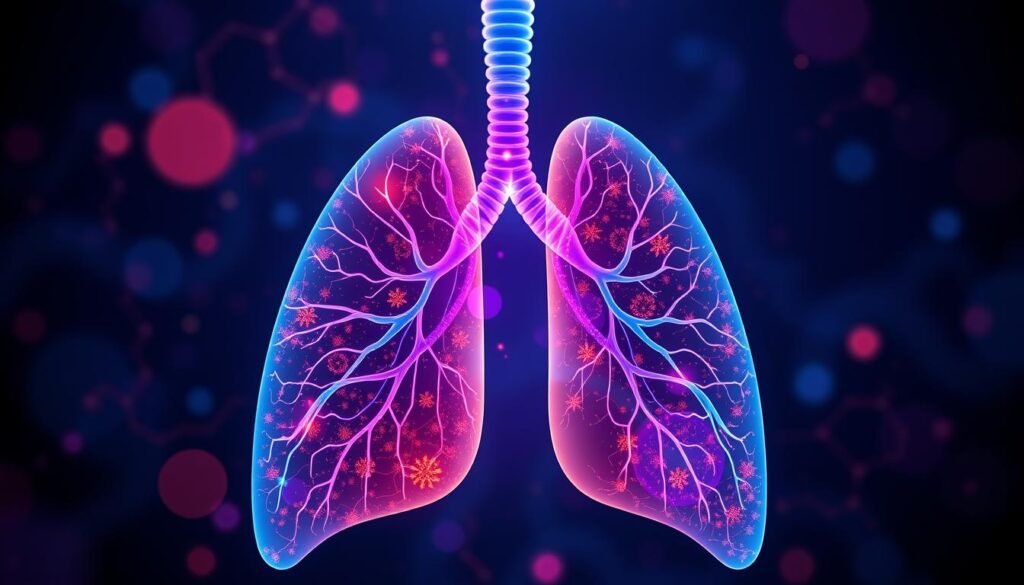About 70% of small cell lung cancer (SCLC) patients discover their condition at an advanced stage. This makes it a particularly tough type of lung cancer to fight. But, recent progress brings hope to those facing this difficult situation. New treatments, like tarlatamab, are changing the game by targeting specific proteins on cancer cells. These advancements could mean better results for patients.
In this article, we’ll dive into the latest ways to tackle small cell lung cancer. We’ll look at groundbreaking developments, what treatments are available now, and research that’s striving to improve care for patients. With these new treatments developing, there’s hope for a brighter future for those dealing with this serious illness.
Key Takeaways
- Nearly 70% of SCLC patients are diagnosed at an extensive stage.
- Tarlatamab shows promising results with 40% of tumors shrinking in clinical trials.
- The median survival time with tarlatamab is significantly higher than standard treatments.
- Innovative therapies are actively being tested, improving prospects for SCLC patients.
- Early detection remains crucial, enhancing treatment effectiveness and survival rates.
Introduction to Small Cell Lung Cancer
Small cell lung cancer (SCLC) is a special, aggressive lung cancer type. It makes up about 10 to 15 percent of all lung cancer cases in the United States. Around 30,000 to 35,000 people are diagnosed with it each year. This cancer grows quickly in lung tissues, different from the more common non-small cell lung cancer. SCLC has two main kinds: small cell carcinoma (often called oat cell cancer) and combined small cell carcinoma.
Smoking is the main risk for getting small cell lung cancer. It greatly raises the risk of many lung cancer types. Secondhand smoke, asbestos, radiation therapy, radon, and air pollution also increase the risk. Having a family history of lung cancer can make it more likely to get SCLC.
People with SCLC may often cough, feel short of breath, have chest pain, wheeze, and lose weight without trying. Finding this cancer early is hard because these signs can be easy to miss. Doctors may use chest X-rays, CT scans, sputum cytology, and biopsies (like fine-needle aspiration and bronchoscopy) to diagnose it.
SCLC is classified into limited-stage and extensive-stage disease. Limited-stage means the cancer is only in specific areas. Extensive-stage means the cancer has spread more widely. Sadly, the outlook for people with SCLC is not good, with many living only 2 to 4 months without treatment. Even with new treatments, living a long time after being diagnosed is still hard to achieve.
Understanding the Aggressiveness of Small Cell Lung Cancer
Small cell lung cancer (SCLC) is a major concern among all lung cancers, making up about 10% of cases. It grows quickly and mutates often, making treatment difficult. Most patients are diagnosed late, with only 30% having limited disease at first.
The outlook for people with SCLC is not good. Those with limited disease can expect to live 15 to 20 months, and those with extensive disease live only eight to 13 months. The five-year survival rate is a low 6%. Knowing how SCLC tumors behave and spread fast is key to finding better treatments.
Treatment for SCLC has been the same for a long time, with the last new drug approved in 1998. Diagnosing this cancer usually involves biopsy and cytology, as surgery is rare. Having other health problems makes treating SCLC even more challenging.
But there’s hope with new therapies like immunotherapy and targeted treatments. These are aimed at helping those with this tough type of lung cancer. Ongoing research is vital to understanding SCLC better and finding effective treatments, as seen in studies like this publication.
Current Treatment Options for Small Cell Lung Cancer
Small cell lung cancer (SCLC) is found in 10% to 15% of lung cancer patients. It grows quickly and is very aggressive. The main plan for fighting SCLC is using chemotherapy and radiation. These treatments aim to slow down the cancer, make patients comfortable, and help them live longer.
Chemotherapy is often the first step in treatment, with a success rate up to 70%. But, its benefits don’t last long. Most patients see their cancer come back within six months. Adding radiation therapy to chemotherapy can make the treatment more effective. It reduces tumor size and helps ease symptoms for patients.
Recently, a new treatment called tarlatamab has been approved. This therapy targets cancer in a new way. It’s not just about chemotherapy anymore. Medical experts are now using a mix of treatments to fight small cell lung cancer more effectively.
Here’s a summary of the primary current SCLC treatments and their characteristics:
| Treatment | Description | Expected Outcomes |
|---|---|---|
| Chemotherapy | First-line treatment aimed at rapidly dividing cancer cells. | Response rate of up to 70%, but often leads to relapse after six months. |
| Radiation Therapy | Utilized to shrink tumors and ease symptoms, particularly in advanced stages. | Helps manage pain and other symptoms, improving quality of life. |
| Tarlatamab (Imdelltra) | FDA-approved bispecific T-cell engager therapy for extensive-stage SCLC. | Provides durable responses, though associated with potential side effects. |
Small Cell Lung Cancer Treatment Breakthroughs
The field of small cell lung cancer (SCLC) research is seeing a lot of new progress. Tarlatamab is a big step forward, giving new hope to patients with tough cases of this disease. After getting the FDA’s nod, this bispecific T-cell engager (BiTE) stands out as a major breakthrough in fighting SCLC.
Tarlatamab: A New Hope for Advanced SCLC
Tarlatamab (Imdelltra) looks promising for patients who haven’t been helped by usual treatments. In a key study named DeLLphi-301, about 40% of folks taking a 10 mg dose saw their tumors shrink. This fact positions it as a key new choice for those with widespread SCLC, offering hope for better survival in a group with few other options.
Mechanism of Action and Efficacy of Tarlatamab
Tarlatamab works by targeting DLL3, a protein often found in high levels in SCLC. It connects T-cells to cancer cells, sparking a strong immune attack against the cancer. This kind of innovation points to a vigorous push to find new treatments for SCLC, aiming to boost the outlook for patients battling this harsh illness.

Innovative Therapies and Advanced Treatments for SCLC
Recent times have brought innovative therapies for SCLC to light. These are designed to boost survival rates and life quality for those fighting this tough disease. Especially, immunotherapies and new agents stand out. They are known for making traditional treatments, like chemotherapy, more effective.
A key breakthrough is Durvalumab, known as Imfinzi. It was tested in the ADRIATIC Phase III trial. The study showed Imfinzi cut the death risk by 27% over a placebo. This is a big deal because before, only 15-30% of those with limited-stage SCLC lived past five years.
Adding Imfinzi to treatments has been promising. It reduces the risk of the disease getting worse or causing death by 24%. At two years, 46% of patients using Imfinzi had no disease progression. This is compared to 34% who took a placebo. This shows the big impact of advanced SCLC treatments.
The fight against SCLC is advancing with new combo therapies being studied. AstraZeneca leads this push, aiming to change how we treat cancer. They are working hard to find treatments that might get rid of cancer altogether. This shows the critical need for more effective SCLC treatments.
| Treatment | Effectiveness | Notes |
|---|---|---|
| Imfinzi (Durvalumab) | 27% reduction in mortality | 57% alive at 3 years; granted Breakthrough Therapy Designation (BTD) |
| Platinum with Etoposide (EP) | 40-70% response rate | 10% achieve complete response |
| Atezolizumab | 12.3 months median overall survival | Hazard ratio for death: 0.70 |
| Durvalumab + EP | Improved OS to 13 months | Compared to platinum-etoposide alone (10.3 months) |
Combination Therapies: Utilizing Topotecan with ATR Inhibitors
In recent studies, the use of combination therapies for SCLC has been a focus. These studies include drugs like topotecan and ATR inhibitors, such as berzosertib. They aim at the aggressive nature of small cell lung cancer. By disrupting important pathways linked to DNA stress common in cancer cells.
Berzosertib and Topotecan: A Powerful Duo
Berzosertib works well with topotecan to improve treatment for small cell lung cancer. Studies have found that ATR, targeted by berzosertib, is more present in cancerous lung tissues. This shows why combining berzosertib with topotecan is effective. Together, they make cancer cells more sensitive to treatment.
Combining ATR inhibitors like berzosertib with other drugs increases the power against SCLC. This approach significantly improves how well treatments work against cancer cell growth.
Activating Immune Responses through ATR Inhibition
ATR inhibitors, including berzosertib, have an important role in boosting immune responses. They increase DNA damage in SCLC, leading to cancer cell death. This not only strengthens the early results but can also improve how well treatments work later on.
Research on ceralasertib and berzosertib shows their impact on SCLC cell lines is promising. The development of these treatments continues to focus on bettering the survival rates for small cell lung cancer patients.

| Cancer Type | Median ATR Expression | IC50 Values (μM) | Response to Treatment |
|---|---|---|---|
| SCLC | 2.2-fold higher than noncancerous specimens | Range: 0.39 to 3.90 | Enhanced suppression with berzosertib |
| Other Lung Cancers | Lower ATR expression levels | N/A | N/A |
These findings highlight the potential of using berzosertib and topotecan together. Ongoing research will continue to explore these strategies. They could make significant progress in treating this difficult cancer. For more details on ATR inhibitors and their role in SCLC, check out this study.
Emerging Treatments for Small Cell Lung Cancer
Small cell lung cancer (SCLC) makes up 10% to 15% of all lung cancers. It’s tough to treat, with survival rates below 9%. There’s a big need for emerging therapies to help patients do better. Many new treatment options for small cell lung cancer look promising and could change how this disease is handled.
Scientists are looking into new kinds of treatments, like antibody-drug conjugates and viral therapies. These emerging therapies might make current treatments work better. They could also fight off drug resistance that SCLC often develops. For example, Imidelltra has shown good results, shrinking tumors in 44% of patients in trials.
Immunotherapy is making progress too. Researchers are trying out new mixtures of it. At the 2022 ASCO Annual Meeting, a study showed serplulimab with chemotherapy improved how long patients lived. Also, a new drug called talazoparib, used with low-dose temozolomide, seems effective for SCLC that involves changes in DNA repair.
The table below shows some key new treatment options for small cell lung cancer being tested in clinical trials:
| Treatment | Type | Mechanism | Response Rate | Notes |
|---|---|---|---|---|
| Imidelltra | Antibody-Drug Conjugate | Targets DLL3 on cancer cells | 44% (tumor shrinkage) | Approved for extensive-stage SCLC |
| Durvalumab | Immunotherapy | PD-L1 inhibitor | Survival increase | Improved survival from 10.3 to 13 months |
| Tarlatamab | Immunotherapy | DLL3 targeting | Shows tumor shrinkage | In clinical trials |
| Talazoparib | PARP Inhibitor | DNA repair pathway target | Pending phase 3 trials | Effective in recurrent SCLC |
| Serplulimab | Immunotherapy | Targets immune checkpoints | Improved survival | Combined with chemotherapy |
There’s a strong effort to find emerging therapies for SCLC. Ongoing trials explore powerful new treatments. This gives hope for managing a very hard-to-treat cancer better.
Clinical Trials and Research in Small Cell Lung Cancer
Clinical trials are crucial in finding better treatments for SCLC. They test new medicines and therapy combinations. The goal is to increase survival rates and lessen side effects. Lately, there’s been progress in SCLC research, focusing on immunotherapy and targeted therapies.
Important studies have improved SCLC treatments. Immunotherapy with chemotherapy has helped patients live longer than with chemotherapy alone. Drugs like serplulimab have shown benefits when used with standard chemotherapy. The 2022 American Society of Clinical Oncology (ASCO) Annual Meeting spotlighted these advancements.
Another advancement is in phase 2 trials of talazoparib with temozolomide. This combo is tested in recurrent SCLC, especially when DNA repair is affected. It’s now moving to phase 3 trials. Such trials highlight how crucial patient participation is in creating new treatments.
Centers like Willamette Valley Cancer Institute back patients entering clinical trials. Lung cancer experts suggest joining these trials for personalized treatment. These trials offer the latest therapies. As research progresses, SCLC trials will keep evolving treatment options, giving hope to patients fighting this tough disease.
Potential Side Effects and Management of New Treatments
New treatments for small cell lung cancer (SCLC) are exciting but come with side effects. One known side effect is cytokine release syndrome (CRS), often seen with immunotherapies like tarlatamab. Handling these side effects carefully is key for the patient’s health.
Understanding Cytokine Release Syndrome
Cytokine release syndrome is when the body reacts strongly to certain cancer treatments. It can cause fever, nausea, fatigue, and headaches. Health care providers must keep a close watch on patients after treatment to catch any early signs of CRS.
This allows them to act quickly to lessen its impact. This approach helps in managing the condition effectively.
Addressing the Challenges of Treatment Administration
Starting new SCLC treatments can be tough, especially if it means staying in the hospital. Patients often need careful monitoring for side effects like low blood cell counts or liver problems. Acting fast is crucial in these situations.
To improve care, setting up special centers for treatment can help. It’s also important for doctors to talk clearly and often about any issues that come up.
Importance of Early Detection and Diagnosis
Finding SCLC early can greatly improve patient outcomes. This is crucial because the disease often shows up late. It’s vital to have strict lung cancer screening protocols. This is to catch this aggressive cancer early. Most lung cancer patients are diagnosed late, at stage III or IV. This greatly lowers their chances of survival.

New technologies in diagnostics, like low-dose CT (LDCT) scans, show great promise. These scans can correctly identify lung cancer 85% of the time. They are 99% specific. Even with a high rate of false positives, the value of early detection is undeniable.
Adding new biomarkers could make early detection even better. This is key for people at high risk, like those 55 to 74 who’ve smoked a lot. These advances show why lung cancer screening is so important.
Lung cancer is set to become an even bigger problem by 2050. Early detection and raising awareness about screenings are key to fighting this. These steps can save lives and improve how patients live.
Doctors and specialists working together is necessary. They can set up good screening programs and find the best treatments early.
| Stage | 5-Year Survival Rate | Median Survival |
|---|---|---|
| Stage IA | ~60% | Varies |
| Stage II–IV | 40% to | 8 to 30 months |
Raising awareness and using effective screening methods can improve SCLC outcomes. It’s important for medical professionals to work on this.
Check out more on lung cancer screenings and new treatments for SCLC at this link. This includes the latest in SCLC care.
Looking Ahead: The Future of Small Cell Lung Cancer Treatment
The future of treating small cell lung cancer (SCLC) looks bright. This is thanks to big advancements in cancer care. They bring together genetics, immunotherapy, and new combination treatments. We have many reasons to be hopeful in fighting this tough cancer.
New treatments like durvalumab and tarlatamab are changing the game for SCLC patients. They offer new hope. Tarlatamab, a special T-cell engager, was fast-tracked for use in May 2024. This shows how quickly new options are becoming available. Studies like ADRIATIC and IMforte are guiding the future of treatment. They are bringing good news for advanced SCLC.
Survival rates are getting better with new treatments. Drugs like atezolizumab and durvalumab are outperforming old-school chemo. Personalized medicine is key. It focuses on treatments that target what makes each SCLC unique. The B7-H3 targeted therapy is a good example. It’s doing well in early tests.
Scientists are diving deep into SCLC’s biology. They’re working towards treatments tailored for each case. Understanding a patient’s genetic makeup is crucial. It helps pick the best treatment. This smarter approach is brightening the outlook for SCLC patients. It promises better treatment results.
Conclusion
The field of small cell lung cancer (SCLC) care is moving forward quickly. New progress shows promise for better patient results. Today, we have treatments like platinum-doublet chemotherapy and new options like Tarlatamab and Lurbinectedin. Patients and doctors are working together to fight this tough disease.
This overview shows us the present and future treatments for SCLC that could change lives. Current research and trials point to better survival rates and life quality with therapies such as prophylactic cranial irradiation and new drug combinations. It’s important for patients to learn about these advances and talk with their healthcare providers about new treatments and trials.
The fight against small cell lung cancer is filled with resilience and hope. By staying informed and advocating for the newest treatments, patients make a strong stand. Knowledge is their powerful tool for a healthier future and longer life.